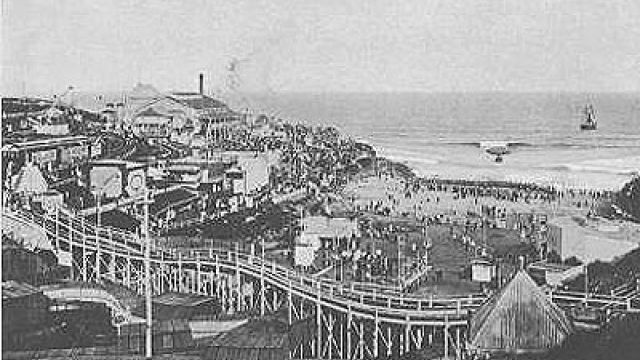How Ambition Ruined Early Aussie Champion of Local Talent
Bendigo-born William Anderson produced melodramas with Australian themes, authentic local settings and local talent, but gambling, on horses and grand schemes, eventually proved his undoing. Leann Richards re-introduces the charismatic showman, once mentioned in the same breath as J.C. Williamson.
In the early 20th century most Australian theatrical entrepreneurs were foreign born. There was one exception, William Anderson. For over thirty years Anderson dominated Australian melodrama and actively supported native writers, actors and producers.
William Anderson was born in Bendigo on January 14th 1868. He began working as a young boy to support his family and his first job was as a bill poster for the local Princess Theatre. He was a charismatic youngster who quickly became popular with the lessees of the theatre, so much so that they allowed him to book all their shows.
Through his work as a booker, Anderson met English actor/manager Charles Holloway. By 1895 he had become Holloway's business manager. However, it was more than business that attracted him to Holloway's company. Its leading lady, Eugenie Duggan, was a talented, attractive and increasingly popular young actress. In 1898 she became Mrs William Anderson and thus began one of Australia’s most popular melodramatic companies, the William Anderson Company.
It was a family affair that featured Eugenie, her brother Edmund and a host of Australian actors. Anderson believed in Australian drama and also supported local writers and set designers, an unusual action for the time. His plays featured realistic sets, Australian themes and Australian accents. Typical of his melodramas was Thunderbolt, a play about the notorious bushranger, Frank Ward. The scenery consisted of gum trees, koalas and an authentic Cobb and Co coach which was driven on stage.
Anderson was a man of grand ambitions and grandiose plans. By 1905 his company was one of the most popular in Australia but William wanted more than a company, he wanted an empire. By the end of that year he was presenting several different productions across Australia and New Zealand. They included Sinbad the Sailor at the Theatre Royal in Sydney, a season of melodrama at The Royal in Hobart and a tour of New Zealand by Czerny, a magician.
William was a gambler who owned several racehorses. According to his long time friend, Jack Ricketts, ‘he was modest in his successes and a sport in his losses'. Anderson’s business decisions combined a gambler’s recklessness with gambler’s luck.
In 1906 he paid £3,650 for twenty acres of land at Tamarama Beach (next to Bondi) in Sydney to build Wonderland City. The amusement park included a circus, flying machines, 1000 seat theatre, aquarium, a maze, a Merry Go Round, skating rink and a miniature railway. There was also a vaudeville act and several novelty features, including Alice the elephant. By the time it opened in 1907, Anderson had spent £15,000 on this folly.
Anderson’s ambitions were endless. In 1907 he hired architect William Pitt to build a grand theatre on Russell Street in Melbourne. The theatre was called the Kings Theatre and Anderson paid a £1000 deposit and committed to a 7-year lease of the building at a grand rate of £4420 per annum. These were enormous sums for the time.
But wait, there is more. In 1906, Anderson toured Wonderland Circus across Queensland. The endless delays and logistical nightmare of transporting a circus which featured exotic animals cost a fortune. But William persisted despite the obvious difficulties.
The Kings Theatre in Melbourne was speedily finished and opened in 1908 with the play Man to Man. The first season featured a series of bush dramas written by Albert Edmunds. The plays had realistic settings and in one case included shearing a sheep on stage.
In 1909 Anderson was featured in The Referee newspaper as one of the preeminent theatrical managers in the country. His picture stood side by side with JC Williamson, Harry Rickards and James Brennan.
However, by 1910 it was clear that Anderson had been too ambitious. The Sydney manager of Wonderland City was being hounded by creditors and desperately asking his boss for funds. Anderson, ensconced at the Kings Theatre, studiously avoided the pleas and his secretary was responding to letters with:
‘So far I cannot get the boss to fix up these outstanding accounts of Sydney. The boss is only here a few minutes every day.’
By 1911 a combination of bad debts and local opposition to the park from swimmers, who had to cut through barbed wire to get the beach, forced Wonderland City to close.
Anderson was in severe financial difficulty. In 1912 he sub-leased the Kings Theatre to Duggan and Bailey, who had a magnificent success with their version of Steele Rudd's On Our Selection. This was another wholly Australian production which would never have been produced without Anderson's financial and logistical support. It became a staple of Australian theatre for decades.
Anderson continued in theatrical production, however he never reproduced his former successes. He moved to Adelaide, and often staged an annual pantomime. However by World War 1 that the public had outgrown his traditional melodramatic fare.
In the 1920s he and Eugenie moved to Melbourne, and the couple separated later in the decade. She died in 1936 and William died shortly afterwards in 1940.
William Anderson was a proud and extravagant Australian entrepreneur who embodied the reckless abandon and creativity of his time. He was a man who thought that Australian product was as good as or better than foreign productions and backed his theory with practical support of Australian actors, writers and artisans.
See more articles by Leann Richards at www.hat-archive.com and www.stagewhispers.com.au
Visit Leann's blog www.hat-archive.blogspot.com/
Image: Wonderland City

